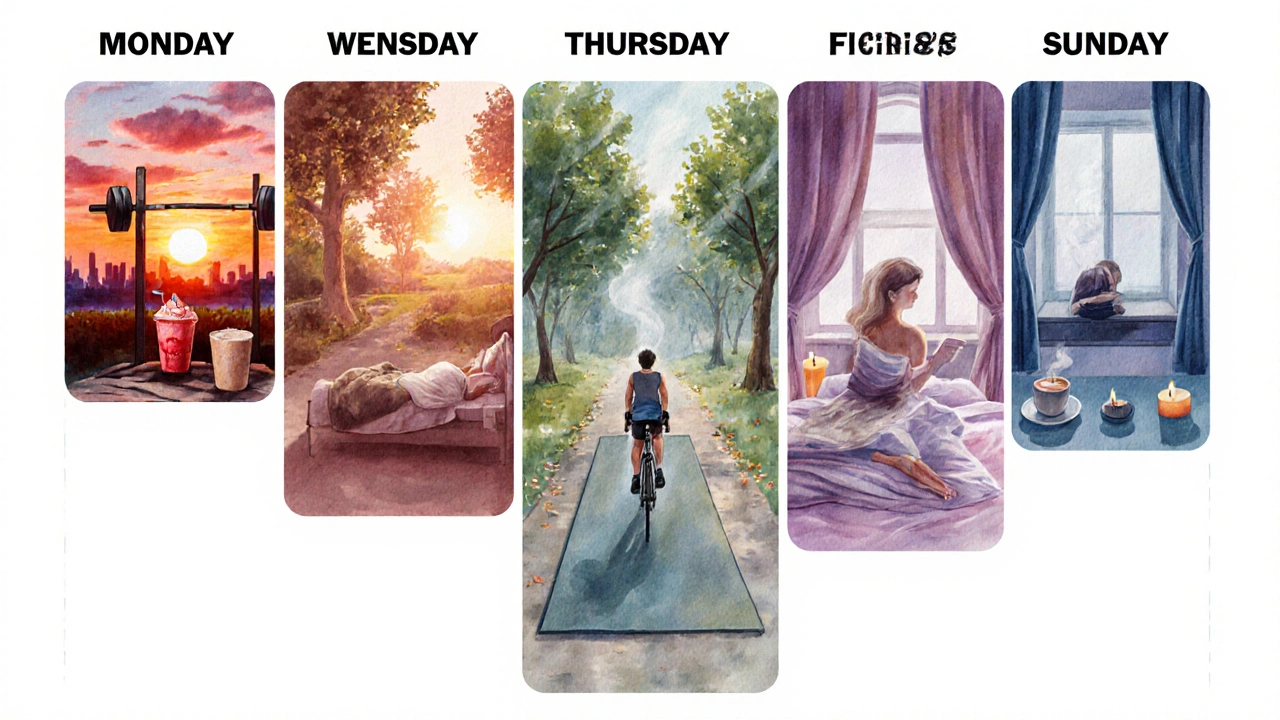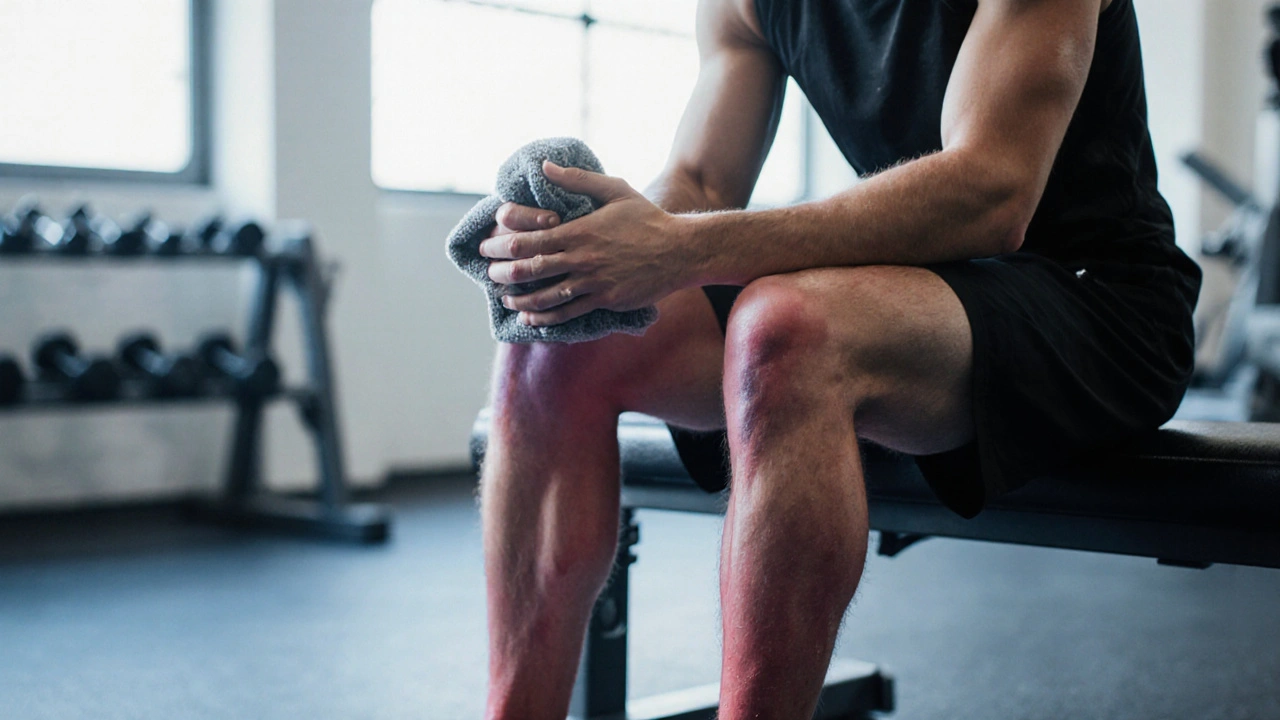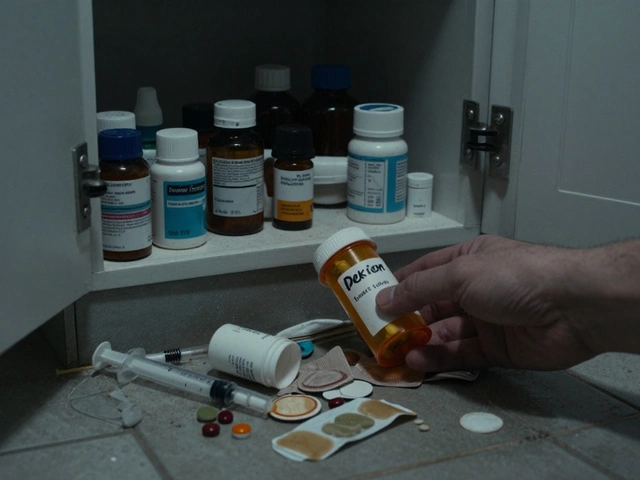Muscle Stiffness Recovery Calculator
Your Recovery Score
Recommended Rest Days
2 days/week
Based on your training schedule
Hydration Tip
2-3 liters/day
For optimal muscle recovery
- Include 1-2 active recovery sessions per week
- Perform foam rolling after workouts
- Get 7-9 hours of quality sleep nightly
- Consume protein within 30 minutes post-workout
Ever hit the gym hard, feel the burn, and then wake up the next morning with tight, painful muscles? That nagging muscle stiffness isn’t just a nuisance-it’s a sign that your body didn’t get the downtime it desperately needs. In this guide we break down why rest and recovery matter, what the science says, and how you can build habits that keep your muscles loose and ready for the next workout.
What Rest and Recovery Actually Mean
Rest and recovery are the processes that allow muscles, nerves, and the whole body to repair, replenish energy stores, and adapt after physical stress. Think of it as the construction crew that shows up after you’ve built a house. Without a crew, the walls stay shaky; without recovery, your muscles stay stiff.
Why Muscle Stiffness Happens
Muscle stiffness refers to a reduced range of motion and a feeling of tightness that often follows intense or unfamiliar exercise. It’s primarily driven by microscopic damage to muscle fibers, a buildup of metabolic waste, and an inflammatory response. The condition is closely linked to delayed onset muscle soreness (DOMS), though the two aren’t identical.
When you push muscles beyond their usual load, tiny tears form. The body floods the area with inflammatory molecules like cytokines, which attract repair cells. While this is essential for growth, the temporary swelling makes the muscle feel rigid. If the repair process is rushed or incomplete, stiffness lingers.
Key Factors That Influence Recovery
- Sleep quality is the most powerful predictor of how quickly muscles heal and how much inflammation subsides
- Hydration helps transport nutrients and flush out metabolic waste like lactic acid
- Nutrition provides the proteins, carbs, and micronutrients needed for tissue repair
- Active recovery light activities that increase blood flow without adding additional stress
- Foam rolling a form of self‑myofascial release that can reduce muscle tension and improve mobility

How Much Rest Is Enough?
The “right” amount varies by training intensity, age, and individual genetics. A good rule‑of‑thumb is to schedule at least one full rest day per week for moderate programs and two for high‑volume strength cycles. For elite athletes, structured periodization-alternating hard weeks with lighter “recovery” weeks-keeps stiffness at bay.
Metrics you can track:
- Heart‑rate variability (HRV). Low HRV often signals insufficient recovery.
- Perceived muscle soreness on a 1‑10 scale. Scores above 5 after a day of rest suggest you need more downtime.
- Performance trends. If lifts or runs are stalling, recovery is likely the bottleneck.
Active Recovery Techniques That Beat Stiffness
| Method | Primary Benefit | Typical Duration | Ideal For |
|---|---|---|---|
| Light Cardio (e.g., brisk walk) | Increases circulation, speeds waste removal | 10‑20 minutes | Post‑strength sessions |
| Dynamic Stretching | Restores range of motion, activates muscles gently | 5‑10 minutes | Before or after workouts |
| Foam Rolling | Reduces fascial adhesion, lowers perceived stiffness | 8‑12 minutes | Targeted muscle groups |
| Massage (self‑or professional) | Decreases inflammation, promotes relaxation | 15‑30 minutes | Chronic tightness |
Pick one or combine a few based on how sore you feel. The key is to move enough to stimulate blood flow but not enough to cause fresh micro‑tears.
Nutrition and Hydration Hacks for Faster Recovery
Protein is the building block of muscle repair. Aim for 0.25‑0.30g perkg of body weight within the first two hours after training. Incorporate fast‑digesting sources like whey or Greek yogurt for a quick spike, then a steady protein source (chicken, beans) later in the day.
Carbohydrates replenish glycogen stores, which are crucial for subsequent workouts. A 3:1 carb‑to‑protein ratio post‑exercise has been shown to reduce DOMS severity by up to 30%.
Don’t forget electrolytes-especially sodium and potassium. They help maintain fluid balance and nerve signaling, both of which influence muscle tone. A simple homemade drink of water, a pinch of sea salt, and a splash of orange juice can work wonders.

Sleep: The Ultimate Recovery Tool
During deep sleep (Stage3), growth hormone peaks, triggering protein synthesis and tissue regeneration. Aim for 7‑9hours of uninterrupted sleep; consistency matters more than occasional binge‑sleeping.
Tips to improve sleep quality:
- Keep the bedroom cool (around 18‑20°C).
- Limit caffeine after 2p.m.
- Use a blue‑light filter on screens at night.
- Consider a short nap (20‑30minutes) if you missed a night of deep rest.
Common Pitfalls and How to Avoid Them
Overtraining is the biggest enemy of recovery. It occurs when training volume exceeds the body’s ability to adapt, leading to chronic stiffness, fatigue, and even injury. Monitoring HRV and keeping a training log can catch early signs.
Another mistake is “gym‑addiction” where people think more is always better. In reality, a well‑structured program balances load, intensity, and rest. Remember: progress is made in the spaces between workouts, not during them.
Lastly, neglecting mobility work. Even if you train hard, skipping regular stretching or foam rolling will let tight fascia accumulate, perpetuating stiffness.
Putting It All Together: A Sample Weekly Recovery Plan
- Monday - Heavy Lift Day: After the session, perform 10min light cardio, then 5min dynamic stretches. Consume 20‑30g protein within 30min.
- Tuesday - Active Recovery: 20‑minute brisk walk + 8‑minute foam roll focusing on quads and calves. Hydrate with electrolyte‑rich water.
- Wednesday - Rest Day: Prioritize 8hours of sleep, light mobility work (yoga or gentle stretching). Eat balanced meals with carbs and protein.
- Thursday - Moderate Session: Include post‑workout protein shake (1:3 carb:protein). Finish with 5‑minute static stretch.
- Friday - Light Cardio + Mobility: 15‑minute cycling at low intensity, followed by a full‑body foam‑rolling routine.
- Saturday - Optional Training or Full Rest: Listen to your body. If you feel tight, choose rest; if fresh, short skill‑focused workout.
- Sunday - Recovery Review: Check HRV, note soreness scores, plan the upcoming week’s load based on how you feel.
This schedule blends high‑intensity work with purposeful rest, ensuring muscles stay supple and performance keeps climbing.
Frequently Asked Questions
How long does muscle stiffness usually last?
Most people feel peak stiffness 24‑48hours after a hard workout, with symptoms fading by day three. If it lingers beyond five days, it may indicate inadequate recovery or a minor injury.
Is complete rest better than active recovery?
Complete rest is useful after very high‑intensity bouts or when you’re extremely fatigued. However, gentle active recovery often speeds up waste removal and can reduce stiffness more effectively than staying motionless.
Can I use over‑the‑counter pain relievers to reduce stiffness?
Occasional NSAIDs can ease pain, but they may also blunt the natural inflammation needed for repair. Use them sparingly and focus on natural recovery strategies first.
Does age affect how much recovery I need?
Yes. Older adults generally experience slower protein synthesis and reduced hormone spikes, meaning they benefit from longer or more frequent recovery periods compared with younger athletes.
What’s the best time of day to do foam rolling?
Either after a workout (to aid removal of metabolic waste) or in the evening before bed (to relax fascia and improve sleep quality). Consistency matters more than the exact hour.











Roshin Ramakrishnan
5 Oct 2025 at 18:24Wow, this article really breaks down the science behind recovery, and I love how it ties sleep, hydration, and active rest together, all in one place. It’s so easy to overlook the little details, like proper foam rolling, which can make a massive difference, especially after a heavy leg day. Remember, consistency is key, so try to schedule at least one full rest day each week, and don’t forget to track your HRV for extra insight! Keep sharing these kinds of practical guides, they help everyone stay injury‑free and keep progressing. 😊